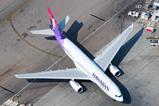Brazilian carrier Azul is not alone in having growth plans stifled by poor turbofan reliability, as carriers worldwide have been hobbled for months by engine issues that have forced them to ground hundreds of jets.
Azul chief executive John Rodgerson told investors during a 3 December meeting in New York City that engine problems are squeezing the Sao Paulo-based carrier’s finances. He also directed sharp criticism toward turbofan makers.
Rodgerson says Azul is reviewing costs as it attempts to free up cash in the coming years, adding that roughly 85% of the company’s capital expenses have been going toward aircraft engines. Azul has also been negotiating with engine OEMs for more-favourable terms.
“There’s a global problem with OEMs today,” he says, specifically calling out Pratt & Whitney (P&W), GE Aerospace and Rolls-Royce. “None of the engine manufacturers are coming anywhere close to how they should be performing.”
Rodgerson says the “majority” of an additional $100 million in cash flow that the airline expects to achieve between 2025 and 2027 will be “going back to those OEMs”.
“Over the last two to three years, what Azul has asked for is payment terms,” Rodgerson adds. “We asked for help from a cash-flow perspective… [We are] saying, ‘Hey, this engine is not performing to the standard that we signed up for, therefore we want to be compensated fairly for it.’”

Azul is seeking unspecified compensation from engine makers amid a broader plan to negotiate with OEMs, lessors and bondholders to de-leverage its business and strengthen its balance sheet.
”It’s not a cash-flow discussion on payment terms anymore,” Rodgerson says. “It’s actually getting the compensation that Azul deserves for the poor performance of the engines.”
Making Azul stronger financially puts it in a better position to negotiate with engine manufacturers, says chief financial officer Alex Malfitani.
“OEMs have restricted capacity to overhaul an engine… If you go to them and say, ‘Hey, I want that capacity to come to me’, they will do it if you’re the horse they want to bet on,” he says. “If you’re asking for improved terms to pay for that overhaul at a time when overhaul is at a premium, they’re going to do it if they see a lifetime value that is worthwhile.
“By enabling an Azul that is going to be much healthier financially, you’re able to get those concessions from OEMs.”
Azul operates a mixed fleet of Airbus A320neo-family aircraft and widebody A330s, Embraer E-Jets, ATR turboprops and Cessna Grand Caravans.
The airline’s fleet of roughly 25 E-Jet E2s (including E190-E2s and E195-E2s) are powered by P&W’s PW1900G geared turbofans (GTF), while its A320neo-family jets have CFM International Leap-1A engines.
P&W has been working through a massive backlog of GTFs that require inspections and replacement parts due to manufacturing defects. The issue can compromise metal components. Airline executives have also complained about other issues that have degraded GTF durability.
Roughly one-third of jets powered by GTFs have been grounded due to engine issues in recent months. Most of the grounded aircraft are A320neo-family aircraft.
“The new-generation engines, they fell short of expectation… It’s not useful to have a very efficient engine if your airplane is still on the ground,” Embraer vice-president of engineering and technology development Luis Carlos Affonso said on 18 November. “I believe the engines will evolve and will deliver. They will be robust over time.”
CFM, which is co-owned by GE Aerospace and Safran Aircraft Engines, has had its own issues with Leaps, including problems involving fuel nozzles and high-pressure turbine blades. Engine makers globally have also been hobbled by broad aerospace supply-chain issues that still linger long after the Covid-19 pandemic.
Azul has acted in recent months secure additional capacity in the form of four used A330s – a response to engine challenges. It expects its capacity will increase roughly 10% next year, with most of the growth coming from international long-haul operations.
Azul fourth-quarter capacity is tracking to increase about 6% year-on-year.
Rodgerson says Azul’s core business model is “very, very strong” despite devaluation of the Brazilian real, aircraft delivery delays, engine issues and its Porto Alegre airport base being closed for several months due to flooding.
Azul reported a profit of R360 million ($59.6 million) in the third quarter, compared with an almost R1.3 billion loss during the prior-year period.































